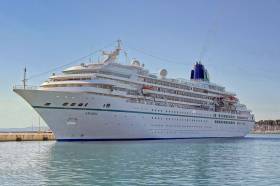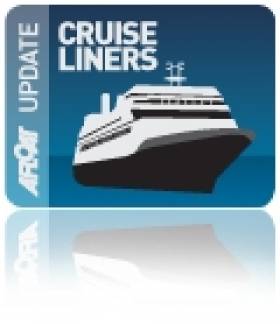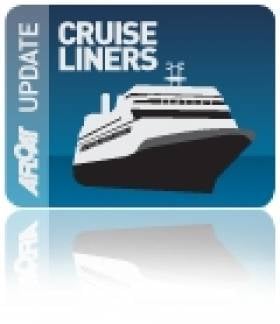Displaying items by tag: Pheonix Reisen
Amadea's Autumn Arrival to Capital of Attractions
#cruiseliners- German cruise operator, Phoenix Reisen have their flagship docked in Dublin Port today, writes Jehan Ashmore.
Passengers from the Amadea are taking in the capital and its various visitor attractionsas as part of an autumn cruise call. Only one more cruiseship is scheduled to visit this season.
The 28,865 gross tonnage Amadea had made an overnight passage from Liverpool. This led to this morning's arrival with the 1991 Japanese built ship taking a berth within the Irish port's Alexandra Basin.
Phoenix Reisen caters not just for the German cruise market but also selling domestic based river cruises.
As far as cruising operations are concerned, asides Amadea, the fleet are represented by Artania, Albatros and a newer addition Deutschland.
The shipping industry is complex given for example that the cruiseship is operated by the German company, flagged in the Bahamas (member of the Commonwealth) and ship management is provided by Monoco based V-Ships in Monte Carlo.
#CruiseMedley – Cruiseships small and large called to the capital to add to the summertime atmosphere of Dublin Riverfest's gathering of tallships that graced the Liffey quays, writes Jehan Ashmore.
Hebridean Sky, the intimate sized ship of just 4,200 gross tonnage had berthed at the North Wall Quay Extension. The pier lies to the east of the Tom Clarke toll-bridge, where the new two-berth cruise berth is to located.
Guests of the Swoop-Antartica adventure ship could been on the uppermost deck at the stern. From this elevated view they could overlook the toll-bridge and beyond to the busy scene of tallships in the direction of the city-centre.
At the end of this ‘extension’ of the North Wall where the tallships met to welcome thousands over the three day event, was berthed in Alexandra Basin the 44,000 gross tonnage Artania. This ship had sailed from Bremerhaven, Germany.
On the Sunday of the Dublin Riverfest, the UK ThunderCat powerboat team were based opposite of the Phoenix Reissen operated cruiseship that been the Poolbeg Yacht Boat Club & Marina. As pictured above the ThunderCats carried out a behind the scene flag-nation display practise involving race-crew members standing on the craft's twin hull.
On the Bank Holiday Monday, Cruise & Maritime Voyages 46,000 gross tonnage Magellan, the UK operator’s current flagship called to the port for the first of five ‘home-porting’ calls. This is where Irish guests can join the 1,450 passenger ship that continued to Liverpool as part of a cruise to the Norwegian fjords.
According to CMV's Irish agent, JMG Travel, these Irish direct cruises have been sold-out. Following their success, a repeat season but with more direct cruises from Dublin is already scheduled for 2018.
The title of CMV flagship for Magellan will however be gone by next year’s season, as of this Thursday, the newly acquired successor is to be named Columbus at a ceremony in London. The 63,000 gross tonnage flagship will too be making a call to the Irish capital later this month. Albeit with a smaller capacity of just 775 passengers.
Also making a call on the Bank Holiday Monday and staying overnight was Hal America Line’s Prinsendam. As previously reported on Afloat, the smallest ship of the HAL cruise-fleet at 37,000 gross tonnage made an appearance for RTE TV's 'The Local Eye' series when calling to Killybegs.
The cruiseship with tiered stern decks remains in port until departing tonight. Likewise of Magellan this cruiseship is also bound for Merseyside.
Finally, the capital port's latest caller, Crystal Symphony docked today in Alexandra Basin. The 51,000 tonnes ship will too overnight and is operated by Crystal Cruises.
First Cruise Caller for More than 20 Years to visit Rosslare Europort
#Cruise&FerryRosslare – Phoenix Reisen's Albratros is to become the first cruiseship caller in more than two decades to visit Rosslare Europort, when she visits in August 2015 bringing new tourists to the south east region.
According to Iarnród Éireann who are the port authority of the ferryport, they say that the cruise ship will call at Rosslare as part of a cruise of Ireland and Britain, which begins from Bremerhaven, Germany.
Other destinations include those in Scotland, Belfast Northern Ireland, the south coast of England and Amsterdam.
A Working Group led by the General Manager Rosslare Europort John Lynch, including representatives of Wexford County Council and Fáilte Ireland and supported by Visit Wexford, have been working on developing the cruise business at Rosslare.
It is hoped that this will be the first of many cruises that will call at the port.
Albatros has a capacity for 850 guests, the majority of whom will be German. The vessel will anchor off Rosslare Harbour with tenders bringing guests ashore.
Attractions that may be part of the land excursion possibly include: the Irish National Heritage Park, the Hook Head Peninsula, the Emigrants' Trail, Wells House & Garden, Wexford Town Walking Tour including the Opera House and many other amenities.
General Manager of Rosslare Europort John Lynch said: "We are delighted to welcome the MS Albatros to Rosslare next year. We are fortunate at Rosslare that not only do we have the capacity to operate as a busy commercial port, but we are also situated in an area of outstanding natural beauty and rich cultural heritage and I believe that there will be many more Cruise Ships that will want to explore the wonders of Wexford and the South East."
German Cruise-Goers On Anchorage Call to Glengariff
At 192m in length, the 600-passenger capacity cruiseship is operated by Pheonix Reisen. The German based travel agency also runs fleetmates Albratross and Artania. The later Finish built vessel was best known as Princess Cruises Royal Princess, when launched by the late Diana, Princess of Wales in 1984.
Apart from the handful of cruiseships that call, Bantry Bay is otherwise used by oil tankers bringing supplies to the Whiddy Island Oil Terminal. The terminal consists of an offshore single point mooring, tanker Jetty, and an onshore tank farm. The bay runs some 35kms long and is 10km wide at its broadest at the entrance and steadily narrows to 3-4kms at its head. In addition the bay is largest of the main inlets in the south-west.
Glengariff in recent years has also welcomed another German operator, Peter Deilmann's Deutschland (1988/22,496grt) and the UK based Cruise & Maritime Voyages Marco Polo (1966/20,080grt). To read more on this vessel which regularly calls to Irish ports click HERE.


























































